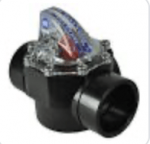Hello everyone-
I've searched for a good answer for this but have yet to find one. I have a 2 year old Doughboy 27' round pool, 54" high. It came with the standard "crappy" vacuum cleaner style 1.5" hoses. I replaced them all with 1.5" PVC pipe the first year. I added a Gulf Stream heat pump last year. The heat pump has 2" inlet and outlets. What I am trying to figure out is if I could have a more efficient system if I replaced everything with 2" PVC. Most things I read are for pools with bottom drains and multiple skimmers and returns. These pools only have 1 skimmer and 1 eyeball return.
Starting from the skimmer and going to the return, this is what I have.
-Large Doughboy skimmer with their hose connection tailpiece. I think I could get creative and enlarge this to 2" with a bulkhead fitting if it would help. It is 1.5" now.
-1.5" PVC (about 8') from skimmer to pump.
-Hayward 2 speed pump (2.25 HP) directly connected to a cartridge filter. Filter area is 175 sq. ft., maximum flow capacity 120 GPM, maximum working pressure 50 PSI. (this filter is 1.5" pipe thread only)
-1.5" PVC (about 5') to heat pump-
-Gulf Stream heat pump 122,000 BTU
-1.5" PVC (about 5') to chlorine tablet feeder.
-1.5" PVC (about 8') to return fitting on pool wall
-eyeball in return is 3/4"
On low speed the filter runs at about 4 psi. On high speed the filter runs at about 12 psi.
Does it make sense to change the filter to something with 2" pipe threads? Will adding any 2" PVC help with flow if I am restricted by the 3/4" eyeball return? I did reduce the 2" heat pump fittings to 1.5" to match the plumbing. Any suggestions to help improve flow and heat pump efficiency?
I've searched for a good answer for this but have yet to find one. I have a 2 year old Doughboy 27' round pool, 54" high. It came with the standard "crappy" vacuum cleaner style 1.5" hoses. I replaced them all with 1.5" PVC pipe the first year. I added a Gulf Stream heat pump last year. The heat pump has 2" inlet and outlets. What I am trying to figure out is if I could have a more efficient system if I replaced everything with 2" PVC. Most things I read are for pools with bottom drains and multiple skimmers and returns. These pools only have 1 skimmer and 1 eyeball return.
Starting from the skimmer and going to the return, this is what I have.
-Large Doughboy skimmer with their hose connection tailpiece. I think I could get creative and enlarge this to 2" with a bulkhead fitting if it would help. It is 1.5" now.
-1.5" PVC (about 8') from skimmer to pump.
-Hayward 2 speed pump (2.25 HP) directly connected to a cartridge filter. Filter area is 175 sq. ft., maximum flow capacity 120 GPM, maximum working pressure 50 PSI. (this filter is 1.5" pipe thread only)
-1.5" PVC (about 5') to heat pump-
-Gulf Stream heat pump 122,000 BTU
-1.5" PVC (about 5') to chlorine tablet feeder.
-1.5" PVC (about 8') to return fitting on pool wall
-eyeball in return is 3/4"
On low speed the filter runs at about 4 psi. On high speed the filter runs at about 12 psi.
Does it make sense to change the filter to something with 2" pipe threads? Will adding any 2" PVC help with flow if I am restricted by the 3/4" eyeball return? I did reduce the 2" heat pump fittings to 1.5" to match the plumbing. Any suggestions to help improve flow and heat pump efficiency?




